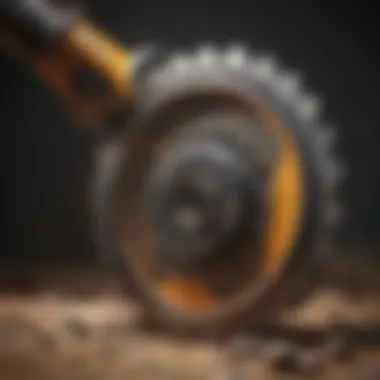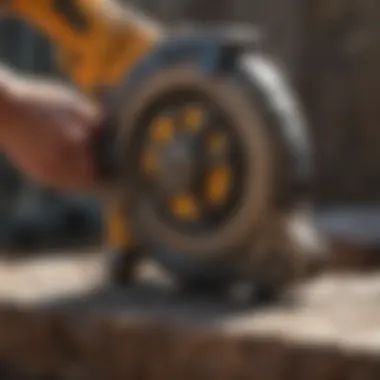Unveiling the World of Portable Rock Saws: Your Ultimate Guide for Rock and Fossil Enthusiasts


Rock and Fossil Identification
In the fascinating realm of rock and fossil identification, enthusiasts encounter a diverse array of geological wonders waiting to be explored. From igneous to sedimentary rocks, and from ammonites to trilobites, the variation in types of rocks and fossils is boundless. Identifying these natural treasures requires meticulous attention to detail, where characteristics such as color, texture, and composition play vital roles in differentiation. Tools like magnifying glasses, hardness picks, and UV lights are indispensable aids in this precise craft.
Collecting Tips and Techniques
Embarking on a rock and fossil collecting expedition demands adherence to best practices to ensure a successful and ethical endeavor. Seasoned collectors emphasize the significance of researching and identifying prime collecting sites to maximize the chances of discovering rare specimens. Upon reaching these locations, safe extraction of specimens becomes paramount, with techniques like using chisels and brushes delicately employed to unearth fossils and rocks without causing damage.
Preservation and Display
Preserving the integrity of collected rocks and fossils is an art form in itself, requiring a delicate balance between maintaining their authenticity and ensuring longevity. Techniques such as encapsulating specimens in resin or storing them in archival-quality containers are commonly employed. When it comes to display, enthusiasts often get creative by setting up themed exhibit cases or utilizing stands and lighting to showcase their prized finds to maximum effect.
Geological Insights
Delving into the geological insights offered by rocks and fossils unveils a tapestry woven with the Earth's intricate history. By studying the formations and processes that shaped these natural artifacts, one gains a deeper understanding of the planet's evolution. Moreover, rocks and fossils hold historical significance, with some specimens dating back millions of years and providing valuable insights into past ecosystems and climates. Notable discoveries in this field continue to shed light on the Earth's past, pushing the boundaries of scientific knowledge in captivating ways.
Introduction
Welcome to the fascinating realm of portable rock saws, a domain where precision cutting meets unmatched convenience for rock and fossil enthusiasts. In this comprehensive guide, we will embark on a journey through the intricacies of these cutting-edge tools, shedding light on their indispensable role in the collection and study pursuits of passionate hobbyists and seasoned professionals alike. From unveiling the defining features to exploring the myriad benefits, get ready to immerse yourself in a wealth of knowledge aimed at elevating your rock and fossil experiences to new heights.
Diving deeper, portable rock saws stand as more than mere tools; they are gateways to unlocking the hidden beauty within geological specimens with unprecedented accuracy and ease. For enthusiasts seeking a trustworthy companion in their exploration of rocks and fossils, understanding the nuances of portable rock saws is paramount. This guide aims to equip you with essential insights into these versatile machines, underscoring their significance in enhancing your fieldwork efficiency and cutting precision. Whether you are a novice or a seasoned collector, the information within these pages promises to unveil a world of possibilities that portable rock saws bring to the table.
Understanding Portable Rock Saws
In this article, Understanding Portable Rock Saws plays a crucial role in enlightening rock and fossil enthusiasts about the intricacies of these tools. By examining the definition, purpose, types, benefits, and considerations of portable rock saws, readers can grasp the significance of integrating them into their collection and study practices. This section will delve deep into the key components of portable rock saws, shedding light on their practical applications and impact on the field.
What is a Portable Rock Saw?
Definition and Purpose
A Portable Rock Saw is a cutting-edge tool designed specifically for slicing through rocks and fossils with precision and ease. The primary purpose of this tool is to enable enthusiasts to extract samples without causing damage or altering the geological structure significantly. Portable Rock Saws are distinguished by their ability to offer a seamless cutting experience while maintaining the integrity of the specimens. This feature makes them indispensable for individuals engaged in geological exploration and fossil analysis tasks, as their non-invasive nature ensures accurate results.
Types of Portable Rock Saws
When it comes to Types of Portable Rock Saws, enthusiasts have a range of options to choose from based on their specific requirements. From handheld electric models to compact gas-powered versions, the diversity in types caters to various cutting scenarios. Each type boasts unique features, such as blade sizes, power sources, and cutting capacities, influencing their suitability for different rock and fossil materials. While some types excel in precision cutting, others prioritize portability and maneuverability, offering users the flexibility to adapt to different field conditions effectively.
Benefits of Using Portable Rock Saws
Portability and Convenience
The aspect of Portability and Convenience sets portable rock saws apart from traditional cutting tools. Their lightweight and ergonomic design allow enthusiasts to transport them easily to different locations, facilitating on-the-go sample extraction. By prioritizing portability, these saws enable users to conduct fieldwork without being hampered by heavy or cumbersome equipment, enhancing their overall efficiency and productivity.
Precision Cutting Abilities


One of the standout features of portable rock saws is their Precision Cutting Abilities, which ensure clean and accurate cuts on various geological formations. Equipped with sharp blades and adjustable settings, these saws can slice through rocks and fossils with unmatched precision, minimizing unnecessary waste or damage. This attribute is particularly valuable for researchers and collectors who rely on precise measurements and cuts to preserve the integrity of their specimens while obtaining informative samples.
Versatility in Fieldwork
The Versatility in Fieldwork exhibited by portable rock saws enables users to tackle a wide range of cutting tasks across diverse geological settings. Whether working on sedimentary rocks, crystalline formations, or fragile fossils, these saws adapt to different materials with ease, showcasing their flexibility and adaptability. This versatility empowers enthusiasts to explore various terrains and collect samples efficiently, making portable rock saws indispensable tools for fieldwork expeditions.
Selecting the Right Portable Rock Saw
When delving into the realm of portable rock saws, selecting the appropriate tool holds paramount significance. The efficiency and precision of your cutting operations hinge on the careful consideration of various factors. Among the key elements to contemplate are the blade types and materials, power source options, as well as the weight and size of the saw.
Key Features to Consider
Blade Types and Materials
In discussing blade types and materials, one must assess how these components directly impact cutting performance and durability. The choice of blade type, whether diamond-tipped or carbide, significantly influences the saw’s ability to traverse different rock densities with ease. Diamond blades are renowned for their exceptional hardness, making them ideal for cutting hard rocks, while carbide blades are effective for softer material. Likewise, the material composition of the blade, be it steel or alloy, contributes to its longevity and resistance to wear.
Power Source Options
The power source is a pivotal consideration when choosing a portable rock saw, as it directly affects the tool’s mobility and operational capabilities. Opting for electric models provides consistent power output for sustained cutting tasks, ensuring reliable performance throughout. On the other hand, battery-powered saws offer enhanced portability, allowing for unrestricted movement in fieldwork settings where electricity may not be readily available.
Weight and Size Considerations
Another critical aspect is the weight and size of the saw, as these factors dictate maneuverability and ease of handling during cutting applications. A balance must be struck between a compact, lightweight design for enhanced portability and a more substantial build for stability and precision cutting. Users must assess their specific needs and working environment to determine the most suitable weight and size profile for their portable rock saw.
Best Practices for Choosing
Researching Brands and Models
Thorough research into brands and models is essential in identifying a portable rock saw that aligns with your cutting requirements. Evaluating user reviews, expert opinions, and product specifications can provide valuable insights into the performance and reliability of various saws in the market.
Budgeting for Quality
While cost considerations are inevitable, prioritizing quality over affordability is key when investing in a portable rock saw. Opting for well-known brands with a reputation for producing durable and high-performing tools might entail a higher initial outlay but can result in long-term cost savings through extended lifespan and enhanced cutting efficiency.
Considering Long-Term Durability
Long-term durability should be a primary concern when selecting a portable rock saw, as the tool's resilience to prolonged use impacts its overall value. Assessing the construction quality, materials used, and potential maintenance requirements of different models can help in making an informed decision that ensures longevity and reliability in fieldwork scenarios.
Using Your Portable Rock Saw
In the vast realm of rock and fossil enthusiasts, the significance of utilizing a portable rock saw cannot be overstated. This section delves into the intricate process of harnessing the potential of your tool to unlock a world of cutting possibilities. Whether you are a novice collector or a seasoned expert, mastering the art of using your portable rock saw is essential for extracting specimens with precision and care. From safety precautions to optimizing cutting performance, every aspect plays a pivotal role in enhancing your fieldwork experience*
Preparing for Cutting


Safety Precautions
When it comes to the intricate dance of rock cutting, safety precautions stand tall as the guardian angels of the process. These measures are not just recommendations but essential protocols that ensure both the operator's well-being and the longevity of the equipment. Prioritizing safety precautions sets the foundation for a seamless cutting experience, mitigating potential risks and accidents that could hamper your exploration journey. From wearing protective gear to maintaining a clear work area, these precautions are the unsung heroes in your rock sawing escapades.
Securing Workpieces
Securing workpieces is akin to setting the stage for a flawless performance. A stable workpiece not only guarantees accurate cuts but also minimizes the chances of mishaps during the cutting process. By meticulously fastening your specimens, you create a controlled environment where precision thrives, allowing you to wield your rock saw with confidence and finesse. The act of securing workpieces may seem mundane, but its impact reverberates throughout the cutting operation, shaping the outcome of your endeavors.
Setting Up Cutting Area
The essence of a well-organized cutting area cannot be understated. An orderly workspace not only enhances efficiency but also streamlines the cutting process, enabling smooth transitions from one specimen to another. By orchestrating a systematic layout for your cutting area, you optimize your workflow, ensuring that every cut is made with care and accuracy. From arranging tools to calibrating lighting, setting up your cutting area sets the tone for a productive and rewarding rock sawing session.
Optimizing Cutting Performance
Applying Proper Pressure
In the intricate dance of rock cutting, the art of applying proper pressure emerges as a critical factor in determining cutting precision and blade longevity. Mastering the delicate balance between too much and too little pressure is key to unlocking the full potential of your portable rock saw. By understanding the nuances of pressure application, you can ensure clean cuts, minimal wastage, and extended blade life*
Adjusting Blade Speed
The speed at which your blade moves through the rock surface holds the power to revolutionize your cutting experience. Adjusting blade speed according to material hardness and desired cut quality can make the difference between a successful slice and a shattered specimen. By honing your skill in blade speed adjustment, you embark on a journey towards unparalleled cutting finesse and efficiency, enriching your exploration endeavors in ways you never thought possible.
Cooling and Lubricating Techniques
As your blade dances through the rock, the necessity of cooling and lubricating techniques becomes increasingly evident. Without proper heat dissipation and lubrication, the blade's integrity is compromised, leading to overheating, wear, and suboptimal cutting performance. Implementing cooling and lubrication strategies not only extends your blade's lifespan but also ensures consistent cutting results, empowering you to tackle challenging specimens with ease and precision. Mastering the art of cooling and lubricating techniques is akin to unveiling a hidden secret that elevates your rock sawing prowess to new heights.
Maintenance and Care
Maintenance and care of portable rock saws are crucial aspects that ensure the longevity and efficiency of these valuable tools for rock and fossil enthusiasts. Proper maintenance not only extends the life of the equipment but also enhances cutting performance, making it essential for those invested in precision and quality. By adhering to a regular maintenance routine, users can mitigate wear and tear, prevent operational issues, and uphold the optimal functionality of their portable rock saws.
Cleaning and Storage
Removing Residue Build-Up:
When it comes to portable rock saws, maintaining a clean blade is paramount to achieving precise cuts and preserving the integrity of specimens. Removing residue build-up ensures that the cutting edge remains sharp and unobstructed, promoting smooth and accurate slicing through various materials. This practice not only enhances cutting efficiency but also reduces the risk of contamination and damage to valuable samples, making it a non-negotiable step in the maintenance process.
Protecting Blades from Corrosion:
Preventing corrosion on blades is imperative for the longevity and effectiveness of portable rock saws. By shielding the blades from moisture and corrosive agents, users safeguard their investment and maintain cutting precision over time. A corrosion-free blade not only ensures smooth operation but also reduces the need for frequent replacements, ultimately saving time and money in the long run.
Proper Storage Practices:
Adhering to proper storage practices is essential for safeguarding portable rock saws during periods of non-use. Storing the equipment in a dry and secure location helps prevent dust accumulation, moisture damage, and environmental contaminants that can compromise performance. By storing the saw in a dedicated space or case, users protect it from physical impact and maintain its operational integrity between uses.


Regular Inspection and Repairs
Routine inspection and timely repairs are vital components of portable rock saw maintenance, allowing users to address issues promptly and prevent further damage. By conducting regular assessments of blade alignment, parts condition, and overall functionality, enthusiasts can identify potential issues early on and take corrective measures to sustain optimal performance.
Checking Blade Alignment:
Verifying blade alignment is crucial for ensuring consistent and precise cutting results with portable rock saws. Misaligned blades can lead to inaccurate cuts, blade damage, and reduced cutting efficiency. By routinely checking and adjusting blade alignment as needed, users maintain cutting accuracy and prolong the life of their saw blades, resulting in superior cutting outcomes.
Replacing Worn Parts:
Replacing worn parts promptly is essential to prevent operational disruptions and maintain the overall performance of portable rock saws. Whether it's replacing a dull blade, worn-out components, or damaged elements, timely part replacement ensures smooth operation and quality cuts. By investing in high-quality replacement parts, users can optimize cutting efficiency and minimize downtime during fieldwork and study sessions.
Troubleshooting Common Issues:
Effective troubleshooting of common issues such as motor malfunctions, power disruptions, or blade inefficiency is key to keeping portable rock saws in prime working condition. By familiarizing themselves with common problems and solutions, enthusiasts can quickly diagnose and resolve issues that may arise during cutting operations. Troubleshooting common issues promptly not only minimizes downtime but also enhances users' overall experience with their portable rock saws, enabling uninterrupted exploration and study opportunities.
Exploration and Fieldwork
In the realm of rock and fossil enthusiasts, the process of exploration and fieldwork holds paramount significance. These endeavours encapsulate the essence of uncovering hidden treasures beneath the Earth's surface, offering a gateway to a realm rich in geological marvels. As enthusiasts navigate their way through various terrains in search of prized specimens, the need for reliable and efficient tools becomes apparent. Portable rock saws emerge as indispensable companions, empowering collectors to extract and dissect rocks and fossils with precision and ease.
Fieldwork Essentials
Transporting Your Saw Safely
Transporting your portable rock saw safely is a critical aspect that demands meticulous attention. Ensuring the secure transit of this valuable tool not only safeguards its integrity but also avoids potential hazards during travel. The design of portable rock saws often entails considerations for portability, emphasizing features such as ergonomic handles and compact dimensions for easier transportation. By adhering to proper securing techniques and utilizing specialized cases or holders, enthusiasts can mitigate the risk of damage and ensure the saw reaches its destination unscathed.
Field Maintenance Tips
Effective field maintenance practices play a pivotal role in sustaining the longevity and optimal performance of portable rock saws. Implementing routine checks and maintenance procedures amidst fieldwork activities can prevent unexpected breakdowns and operational setbacks. From blade inspections to motor efficiency assessments, conscientious maintenance fosters a seamless cutting experience, enabling enthusiasts to focus on their geological pursuits without interruptions.
Utilizing Saw in Various Geological Settings
The versatility of a portable rock saw shines brightest when applied across diverse geological settings. Whether amidst rocky cliffs, sandy dunes, or lush forest floors, the adaptability of these saws is a testament to their engineering ingenuity. By tailoring cutting techniques to suit specific rock formations and structures, enthusiasts can unlock unparalleled precision in specimen extraction. This adaptability ensures that the portable rock saw remains a valuable ally in navigating the myriad landscapes encountered during geological exploration.
Documentation and Cataloging
Recording Cutting Data
The meticulous record-keeping of cutting data represents a crucial aspect of the exploration and documentation process for rock and fossil enthusiasts. By meticulously documenting cutting parameters, including blade types, cutting angles, and specimen characteristics, collectors establish a comprehensive log of their extraction methods. This data not only facilitates future reference but also contributes to scholarly observations and analyses, enriching the collective knowledge within the enthusiast community.
Labeling Specimens
The practice of labeling specimens serves as a fundamental organizational strategy for enthusiasts engaged in rock and fossil collection. By affixing detailed labels to specimens, including pertinent information such as collection location, geological strata, and extraction date, collectors create a robust catalog of their discoveries. These labels serve as chronological markers of each specimen's journey, ensuring traceability and contextual relevance in subsequent research and study endeavors.
Creating Digital Archives
In the digital age, the creation of digital archives emerges as a contemporary approach to cataloging and preserving rock and fossil collections. By digitizing documentation, including photographs, cutting data, and specimen details, enthusiasts safeguard their findings against physical deterioration and loss. Digital archives offer accessibility and portability, allowing collectors to share their discoveries with a global audience, fostering collaborative research initiatives and innovative geological studies.
Conclusion
The Conclusion section of this exhaustive guide serves as the pinnacle of knowledge amalgamated throughout the narrative on portable rock saws. It encapsulates the essence of how crucial it is to comprehend the nuances of choosing, utilizing, and maintaining these sophisticated cutting tools. In the realm of rock and fossil enthusiasts, a practical understanding of portable rock saws is akin to possessing a key for unlocking the hidden treasures within geological formations. The relevance of this final segment lies in its ability to synthesize intricate details discussed in prior sections, offering a holistic view of the subject matter. By reflecting on the benefits of employing portable rock saws, enthusiasts gain insights into optimizing their cutting techniques, ensuring precise results with each operation. More than just a tool, these saws represent a gateway to exploring the geological wonders tucked away in rock formations, enriching the pursuit of collecting and studying rocks and fossils. The robust narrative thread woven throughout this guide converges seamlessly in the Conclusion, enlightening readers and empowering them with comprehensive knowledge essential for navigating the world of portable rock saws.







